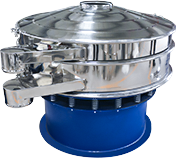Circular vibrating screens and linear screens are widely used screening equipment in daily production. The basis for distinguishing them is the operating trajectory. The material on the circular vibrating screen moves in a circular trajectory, while the material on the linear screen moves in a straight line. The specific operation trajectory is shown in the following figure


Working principle of circular vibrating screen
The three-dimensional rotary vibrating screen is excited by a vertical motor, with eccentric heavy hammers installed at the upper and lower ends of the motor. The rotating motion of the motor is transformed into horizontal, vertical, and inclined three-dimensional motion, and this motion is then transmitted to the screen surface, causing the material to undergo outward expansion and involute movement on the screen surface.
Working principle of linear screen
Using vibration motor vibration as the vibration source, the material is fed into the equipment while moving towards the discharge port. The material evenly enters the feeding port of the screening machine from the feeder, and through multiple layers of screening, various specifications of screened materials are produced. The undersized materials are discharged from their respective outlets.
In addition to different working principles, the differences between circular vibrating screens and linear screens are summarized as follows:
1. Motion trajectory
The material on the circular vibrating screen moves in a circular motion, while the material on the linear screen moves forward in a straight line.
2. Hole blockage phenomenon
The material of the circular vibrating screen moves in a parabolic circular track on the surface of the screen, making the material dispersed as much as possible, improving the bounce force of the material, and allowing the material stuck in the screen hole to jump out, reducing the phenomenon of hole blockage.
3. Installation layout
The circular vibrating screen occupies a small area, while the linear screen has a lower height due to the small inclination angle of the screen surface, making the process layout convenient.
4. Production capacity of vibrating screen
According to the size of the material particles, generally speaking, the production capacity of the rotary vibrating screen is smaller than that of the linear screen, but it also depends on the specific material.
5. Materials
Two types of equipment can be selected based on material characteristics, such as material contact SUS304, or carbon steel or all stainless steel.
6. Applicable fields
Any particle, powder, or range in various powder industries can be screened.
Linear sieve is mainly used to screen fine particle materials with a light specific gravity. For materials with low hardness, dry test powder, fine particles or micro powders are mainly used in the food, chemical, building materials, and pharmaceutical industries.
Understand the difference between circular vibrating screens and linear screens, and select the appropriate machine based on the project requirements and the processing capacity of the vibrating screen.

